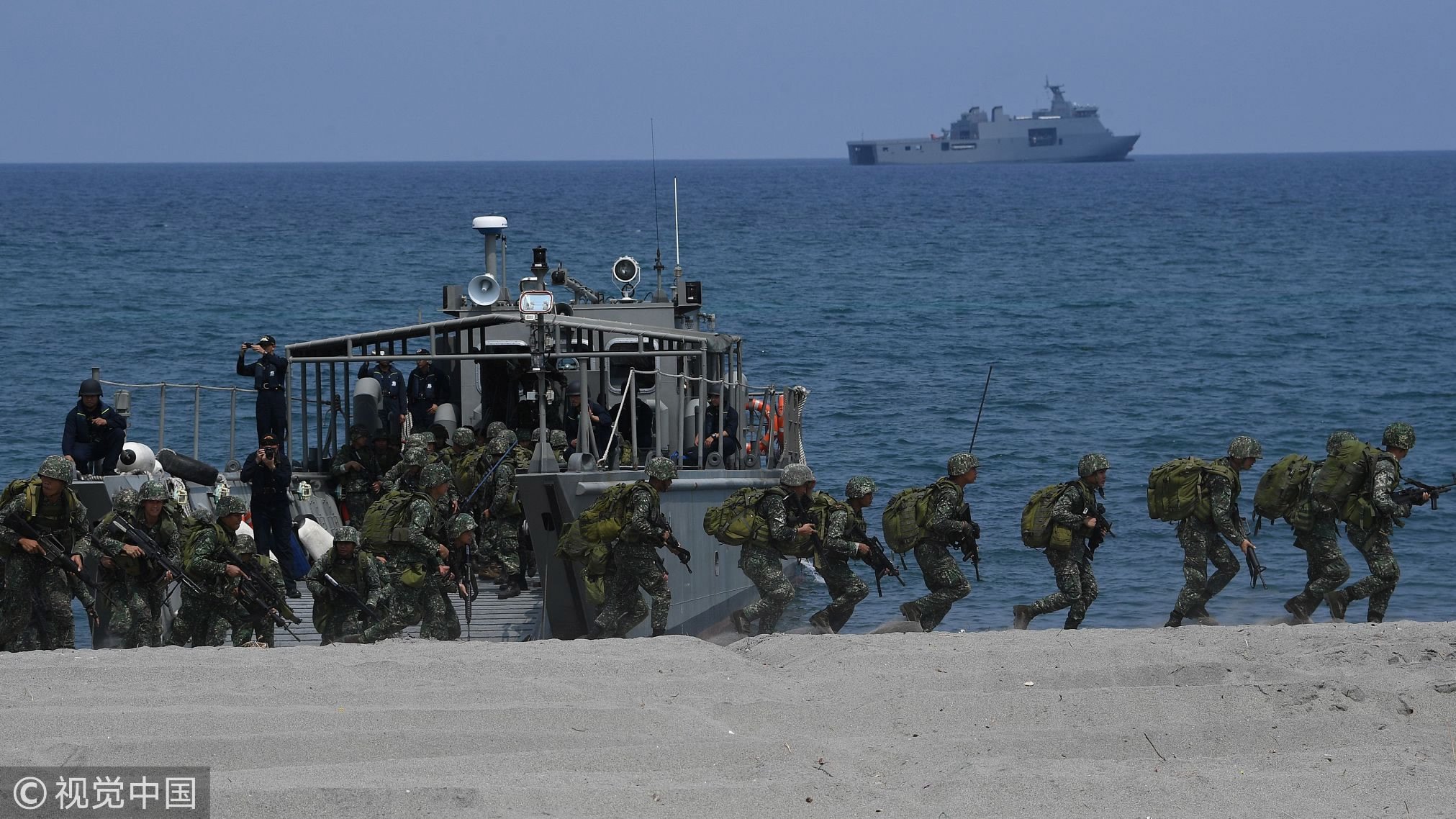
Opinions
09:54, 14-May-2018
Opinion: Balikatan 2018 doesn't aim at China
Guest commentary by Wang Peng

The 34th iteration of the "Balikatan," the biggest annual bilateral exercise involving the United States and the Philippines, is reportedly taking place from May 7 to 18. This year’s iteration has been scaled up relative to the previous year, focusing on a variety of missions including humanitarian assistance and disaster relief, counterterrorism and mutual defense, as well as interoperability training events designed to enhance the combined capabilities of both the Philippine and US armed forces.

The Philippines' exercise head Lieutenant General Emmanuel Salamat (L) shakes hands with his US counterpart Lieutenant General Lawrence Nicholson during a press conference after the opening ceremony of the joint US and Philippine military exercise at the military headquarters in Manila, May 7, 2018. /VCG Photo
The Philippines' exercise head Lieutenant General Emmanuel Salamat (L) shakes hands with his US counterpart Lieutenant General Lawrence Nicholson during a press conference after the opening ceremony of the joint US and Philippine military exercise at the military headquarters in Manila, May 7, 2018. /VCG Photo
This year's Balikatan certainly constitutes a major boost relative to 2017. For example, the troop numbers this year are up to 8,000 – 5,000 from the Armed Forces of the Philippines (AFP) and 3,000 from the US, while about 5,000 participated last year. As in the past two years, the Japanese and Australian armies are also taking part.
Background: US-Philippine relations are normalizing
The fluctuating relations between the US and the Philippines, which dropped from the honeymoon between Obama and Benigno Aquino III to the bottom of the valley when political “strongman” Rodrigo Duterte came to power, have now started to enter a process of normalization.
The current normalization is the key to helping international observers understand the strategic influence of these drills.
In history, the longstanding ties between Manila and Washington have been strong and described as a “special relationship.” The Philippines has been one of the oldest and also the most loyal Asian partners of the US and a strategically major non-NATO ally. The US-Philippines Alliance also plays a pivotal role in maintaining the American military existence in Southeast Asia. The Barack Obama administration made the Philippines the most pro-American country in the world, especially during the most stressful moments related to the South China Sea.
However, current Philippine President Rodrigo Duterte, who formally assumed the office on June 30, 2016, is supportive of a foreign policy that is less dependent on the United States, favoring one that prioritizes closer relations with China instead. In doing so, he announced a “separation” from the United States, both militarily and economically, in favor of alliances with China and Russia on October 20, 2016.

Philippine and US marines take position aboard an assault amphibious vehicle (AAV) during the amphibious landing as part of the annual Philippine and US joint military exercise at the beach of Philippine navy's training camp in San Antonio, Zambales Province northwest of Manila, May 9, 2018. /VCG Photo
Philippine and US marines take position aboard an assault amphibious vehicle (AAV) during the amphibious landing as part of the annual Philippine and US joint military exercise at the beach of Philippine navy's training camp in San Antonio, Zambales Province northwest of Manila, May 9, 2018. /VCG Photo
A few weeks after the split in public, Duterte urged American Special Forces to cease operations and leave Mindanao. During an official visit to Vietnam on September 28, 2016, Duterte explicitly said that it was time to end the Philippines’ joint military exercises with the United States. He announced that the upcoming scheduled drills will be the last one under his administration. However, he continued to uphold the Philippines’ treaties with the US.
After the 2016 US presidential election, Duterte said that he will stop quarrels with the US following President Donald Trump’s victory. In return, Trump has promised to continue to provide aid to the Philippines during his presidency. From this moment, their bilateral relations began to hit the tip of the iceberg.
Evaluation: A threat to China?
Experts worried whether the enlarged scale of the joint exercises poses a threat to China and Sino-Philippine relations? In anticipation of this situation, Duterte emphasized that the drills were not designed to provoke Beijing. Are his words trustworthy for China?
The answer should be yes. First, China-Philippines relations are totally different from the time of the Benigno Aquino III administration. Now the level of mutual trust between Beijing and Manila has reached a new high. With the increasing confidence of their bilateral ties, Beijing has made a very tolerant degree of expression toward these drills.
Second, in terms of the detailed subjects of this exercise, it is hardly surprising that the Philippines cooperated with Americans in order to check and balance China. Actually, they both focus on non-traditional security issues, such as anti-terrorism and humanitarian assistance.
As a result, there are no wrong anti-China conspiracies in the perspective of Beijing. There is only the fear of making the wrong perceptions and choices. The two giants across the Pacific Ocean have to finally find the way to accommodate their existence, build mutual trust and promote common prosperity for all people and states in the region.
(Wang Peng is a research fellow at the Charhar Institute. His areas of research include CPC building, Chinese foreign policy and Asia-Pacific international security. The article reflects the author’s opinion, and not necessarily the views of CGTN.)

SITEMAP
Copyright © 2018 CGTN. Beijing ICP prepared NO.16065310-3
Copyright © 2018 CGTN. Beijing ICP prepared NO.16065310-3